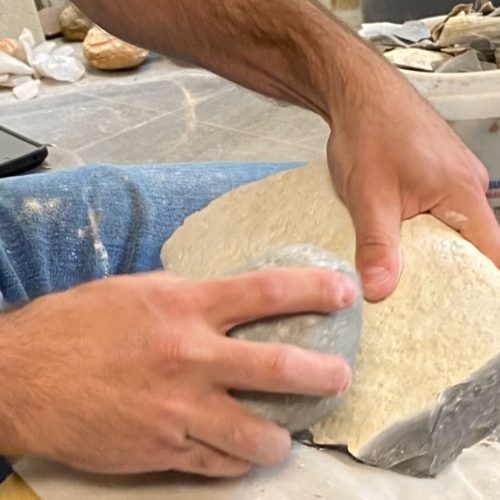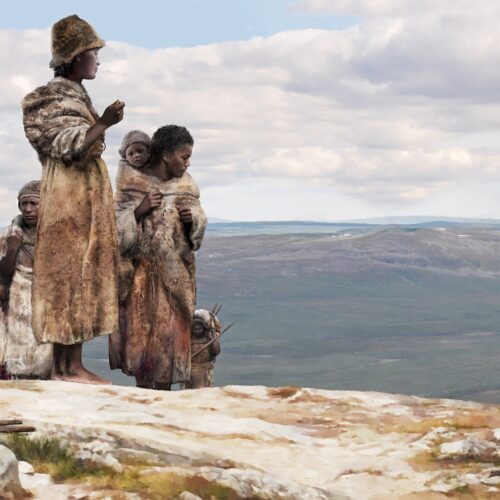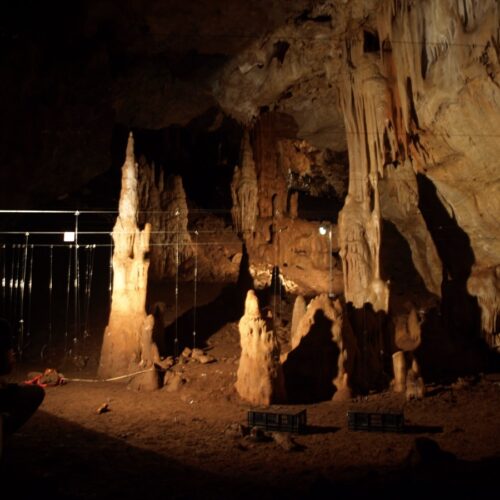5 times entire towns were found buried

Wirestock Creators/Shutterstock
- Throughout human history, cities have been abandoned or reclaimed by nature.
- Sometimes people rediscover these cities using technology or by a stroke of luck.
- These five cities, buried under rock, ice, or vegetation, have resurfaced.
Humans have been building cities for centuries, but they don't always last. In some cases, nature has reclaimed them. Other times, people simply built on top of older structures.
Technology, including lidar and radar, helps uncover some lost or abandoned cities. Warming temperatures and drier conditions have caused other towns to resurface.
Here are five hidden cities buried by rock, snow, or vegetation that people have rediscovered.

Michala Garrison and Jesse Allen/NASA Earth Observatory ; Chad Greene/NASA/JPL-Caltech
In April 2024, NASA Jet Propulsion Laboratory scientists accidentally caught a glimpse of the Cold War past, buried 100 feet under Greenland's frozen landscape.
Over 900 miles north of Nuuk, the country's most populous city, there was once a secret town of Army workers. Now the only way to see the frozen city, known as Camp Century, is through ice-penetrating radar.
"It's sort of like an ultrasound for ice sheets, where we're mapping out the bottom of the ice sheet," Chad Greene, the cryospheric scientist who took the picture, told Business Insider.
While there are other radar images of Camp Century, this newer device, the UAVSAR (Uninhabited Aerial Vehicle Synthetic Aperture Radar), is more powerful. "That is the highest-resolution image that we've ever gotten to see at this camp," Greene said.

Pictorial Parade/Archive Photos/Getty Images
Remote and inhospitable, northern Greenland seemed like an ideal place for a Cold War military base. The US Army Corps of Engineers started constructing Camp Century 26 feet below the ice in 1959.
They dug tunnels large enough for an electric railroad to connect to a supply base over 150 miles away. The 2-mile-long complex, powered by a nuclear reactor, was large enough for 200 soldiers. So they didn't miss the comforts of home, they would have access to a gym, game rooms, library, and barber shop, Popular Science reported in 1960, while the base was still under construction.
The Army told journalists that scientists used Camp Century as a base for collecting and researching the world's first ice core samples. While that was true, the frozen city was also part of Project Iceworm. That mission, to launch ballistic missiles from under the ice, was kept under wraps and was eventually scrapped.

US Army/Pictorial Parade/Archive Photos/Getty Images
The Army's expectation for Camp Century after abandoning it in 1967 was that snowfall would keep it "preserved for eternity," a group of engineers wrote in a 1962 journal article. Over the decades, dozens of feet of ice and snow have further covered the base. The problem is that warming temperatures could reverse that trend.
If Camp Century melts, thousands of gallons of radioactive waste could surface as well. A 2016 study predicted the area will start losing ice by 2090.

Luke Auld-Thomas/Tulane University
Luke Auld-Thomas was deep in a Google search when he hit the jackpot … for a graduate student in archaeology, at least. It was lidar data for environmental analysis, but he was interested in what was under the trees.
To capture that kind of information, a plane flies over an area and the lidar sensor emits millions of pulses of light that are used to measure the distance between the plane and the objects below. Some light slips between the tree canopy to the ground, which can reveal forgotten structures.
The dataset covered an area of Campeche in Southeastern Mexico where Lowland Maya civilizations once flourished. However, the area is so dense with trees, it's impossible to see structures from the sky. Archaeologists had never studied this particular spot, so Auld-Thomas wasn't sure what the data would show.
It turned out that there were thousands of structures under the leaves.
"The locals were aware of the ruins nearby, but the scientific community had no idea," Marcello Canuto, a Tulane University professor and Auld-Thomas' advisor, told Business Insider.

Luke Auld-Thomas/Tulane University
When Auld-Thomas and Marcello started looking at the lidar data, they were surprised to see an entire city, packed with buildings. It may have been home to 30,000 to 50,000 people between 750 and 850 CE.
The city covered around 6 square miles. The team found over 6,700 structures, including houses, plazas, temple pyramids, and a ballcourt. Some areas were dense while others were more rural, Canuto said.
"There's also causeways, like roads, terraces, hydraulic canals, reservoirs, things that suggest that the landscape is being modified for a series of reasons," he said, including transportation and growing food.
Based on the city's scope, Canuto said it may have served as a regional capital that would have been home to elites or a royal family.
The researchers called it Valeriana, after a nearby lagoon.

Andrea Sosa/Picture Alliance via Getty Images
Right now, everything the researchers know about Valeriana comes from the lidar data. That information can help see the size and shape of buildings and the size of the city, but they need to visit the site to learn more.
"What lidar doesn't tell you is what's below the surface," Canuto said. The Maya may have buried some objects or structures, or soil may have covered them.
Canuto said many of the stone buildings have likely crumbled over the centuries. They may be decorated or have important architectural features that lidar can't reveal.
While Canuto isn't planning to go to Valeriana himself, he hopes researchers from Mexico's National Institute of Anthropology and History will study the site.
"That's the point of open data is to say, 'Look, it's open to everybody, so make use of it,'" he said.

Lauren Dauphin/NASA Earth Observatory ; US Geological Survey
A decades-long megadrought continues to bake the Southwestern US.
In the early 1980s, Lake Mead, the Hoover Dam's reservoir, was nearing its full capacity of 9.3 trillion gallons of water. In 2022, it was at its lowest level since 1937, when it was first filling up, according to NASA's Earth Observatory.
Satellite images showed a "bathtub ring" of mineralization where water previously covered the shore. A once-wide section of the lake narrowed and then disappeared in the past 20 years.
As the evaporating water revealed the bed below, the remnants of an abandoned town began to emerge.

National Park Service
In 1928, President Calvin Coolidge signed a bill ordering the construction of what would become the Hoover Dam. It was completed in 1936, causing the Colorado River to start rising.
As water pooled in valleys, Lake Mead began to form. Unfortunately for the residents of St. Thomas, Nevada, they were right in its path.
Mormons settled the town in 1865, though most burned their homes and moved after a dispute over taxes, according to the National Park Service. By the 1880s, newcomers had found the town, which would eventually become home to around 500 people.
When the river water started flooding, the town had everything from a school to a post office to an ice cream shop.
In 1838, the last resident escaped by boat.
"St. Thomas, for a long time, you couldn't get to without scuba diving," Michael Green, a University of Nevada, Las Vegas history professor, told The Las Vegas Review-Journal in 2019.
The drought changed that.

Ethan Miller/Getty Images
St. Thomas started peeking through the disappearing lake in 2002. Walls, foundations, bits of metal, and broken glass litter the earth now.
The town reemerged in 1945 and 1963 but the lake swallowed it up again. It's unclear when that may happen again because climate change is fueling water loss in the Colorado River, a 2023 study found.
Lake Mead rose 16 feet in 2024 after coming dangerously close to the "dead pool" level, when the Hoover Dam would no longer be able to release water downstream to Arizona and California, SFGate reported.

Yasin Akgul/AFP via Getty Images
Midyat, in southeastern Turkey, has long held religious significance, as evidenced by its monasteries and churches, some of which were built in the 6th century.
In 2020, researchers on an excavation project unexpectedly found an entrance to a sprawling subterranean city, Agence France-Presse reported in 2024. Its construction was even older than the above-ground churches, dating back almost 2,000 years.
The city's inhabitants, possibly fearing persecution, fled underground and created an entire world.

Yasin Akgul/AFP via Getty Images
Tunnels carved into the rock connect dozens of rooms in the underground city, known as Matiate. Researchers found coins, human and animal bones, and areas for storing food and wine, The Wall Street Journal reported in 2022.
People occupied the site for hundreds of years and had many reasons for seeking shelter under ground.
"To protect themselves from the climate, enemies, predators and diseases, people took refuge in these caves, which they turned into an actual city," Mervan Yavuz, the Midyat conservation director, told AFP.
Some may have been looking for a place to safely practice their religions, Yavuz added. "Pagans, Jews, Christians, Muslims, all these believers contributed to the underground city of Matiate."

Yasin Akgul/AFP via Getty Images
Workers have only excavated a tiny fraction of Matiate, which covers an estimated 9 million square feet.
"Our aim is to gradually uncover the entire underground city and open it to tourists," excavation leader Gani Tarkan told Daily Sabah last year.
Eventually, Matiate could rival the size and popularity of another of Turkey's underground cities, Derinkuyu.

LiskaM/Shutterstock
In 1963, a man in the Cappadocia region of Turkey kept losing chickens during renovations on his basement, the BBC reported in 2022. They would slip through a gap in the wall and disappear. It turned out the wall concealed a tunnel to a long-forgotten city.
Located nearly 280 feet under the ground, the cavernous rooms and tunnels were once home to 20,000 people.

Pakhnyushchyy/Getty Images
Cappadocia's rock is made from volcanic ash and forms natural spires. Known as tuff, the rock is easy to carve and shape, which may have helped residents build the underground tunnels and dwellings.
The city is ancient, with some estimates of its age at around 3,000 years. In 370 BCE, Xenophon of Athens described a site that seemed to match what's now known as Derinkuyu.
After its rediscovery, archaeologists and others began excavating Derinkuyu, eventually finding over 600 openings leading to the city. Storage rooms, stables, and schools covered 171 square miles. There was a well for water and ventilation shafts bringing in fresh air.
While residents didn't seem to live underground permanently, they could hide from violence or harsh weather for months at a time, the BBC reported.

Omar Haj Kadour/AFP via Getty Images
In the 1920s, Cappadocian Greeks left the city behind after the Greco-Turkish War. They likely knew about the metropolis beneath their feet but took that knowledge to Greece.
Following Derinkuyu's rediscovery, it became a huge draw for the region.
Visitors can now explore several levels of Derinkuyu to see how people sought refuge for hundreds of years in the claustrophobic caves.



















